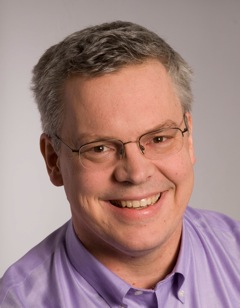

The CM-5 paper won the innaugural 2023 SPAA Test-of-Time Award.
I left Google in January 2023.
I am cited as a contributor to the Akamai Content Delivery Network, which won the 2008 ACM SIGCOMM Networking Systems Award
Our paper "Optimizing Every Operation in a Write-Optimized File System" won the best paper award at FAST 2016.
Our paper "BetrFS: A Right-Optimized Write-Optimized File SYstem" won runner up for best paper at FAST 2015.
I released SuperMalloc in 2015.
My Cilk entry won the HPC Challenge Class 2 (Most productivity) award for "Best Combination of Elegance and Performance".
I worked at Google from 2020 to 2023 on the cache infrastructure for Google's content delivery offering.
I worked at Oracle from 2016 to 2020 on their cloud file storage service.
I was a Research Scientist in the Supercomputing Technologies Group at the MIT Laboratory for Computer Science.
Before that I was Akamai Technologies, and before that I was an assistant professor in the Yale University Department of Computer Science with a joint appointment in the Yale University Department of Electrical Engineering.
I've been involved with several startups.
My research applies algorithm design to solve systems problems in high-performance computing. I was one of the principal architects of the Connection Machine CM-5, and am the co-author of two world-class computer chess programs (StarTech and *Socrates.) I participated at MIT in the Cilk development project, which provides an algorithmic multithreaded programming system.
As an assistant professor at Yale I worked on the Ultrascalar Project, in which we improved the theoretical bounds for how fast a superscalar processor's clock can run, as a function of the window size or the issue width. We also had an 8-issue out-of-order processor fabricated in a 0.18 micron copper/low-K VLSI process. We also worked on developing the mechanisms for a speculative dataflow processor.
One tool I often use in my projects is to measure the use of critical-path length to understand the inherent parallelism of a program. The Cilk paper explains in detail what critial-path length is and how to use it
In my microprocessor research, we actually measure the critical-path length of ordinary serial programs.
My wide-area multithreading research investigates how to run Cilk programs efficiently on the internet. I want to build a chess program that runs on 100,000 processors on the web. Needless to say, there are interesting problems. Mike Bernstein, working under my supervision, has built a version of Cilk that can run efficiently with limited bandwidth, such as is found on the internet.
For the purposes of a morality play, I have finally put a picture of myself on the web.
I visited Connection Machine Services (all that is left of the
Thinking Machines computer business) one day in May 2000:
And scored a CM-5 LED board:
How the mighty have fallen:
| On Campus: | Bradley C. Kuszmaul |
| MIT Computer Science and Artificial Intelligence Laboratory (MIT CSAIL) | |
| Email: | bradley@mit.edu |
-----BEGIN PGP PUBLIC KEY BLOCK----- Version: GnuPG v1.0.6 (GNU/Linux) Comment: For info see http://www.gnupg.org mQGiBD3wy6YRBADkSn9bS/wFDQpwPVMnC3qduTUFeEP3xPMQkB4tycf0Bq9Kk5SX /GlTST8pS64Lr3h0h1dou7rltCNj5e7HZblLSHovNri+N2EsmFNUJu6JJrg1nas7 6FfVxIx7A7DulEIEFB/Y20dzT4m9/Pk6pKxmNFRjJfmyHs3mdMvN+wyzuwCgjxeC EPGRHW1fL+GKhCyhIXNK6XcEAL9I9qQ0kqbSIXLBPJ5Eio/3ycqrn/k/jILaboKi 3VkgaGBJIgm+acSzoU6SAoxPy6bUbHmVN/+PEox84/i+N5PRTorgQ7pA9pn99J40 qf7MHI+wYGPud5KqkvwfGzKAsA7+ObW/nJkH9BezLhOM9w7kPhe4UAM5oJTVbXfc OuHOBADQA3JdC4Uxradb7W0CZMFYVzBhWAP9A40djOJvJzcqy5IPt1OyTBzWglj8 XTUY8FE1KSrNsTj3+pHvVN3YjyrrjHUZzqgN9Absln778j/LRu8AYbAl0oNaQ9xO GoZ/5Lf+VjpX3GkE92p1EPuGjREgYMo77fAF3aXtjJnu7hmRu7QlQnJhZGxleSBD LiBLdXN6bWF1bCA8YnJhZGxleUBtaXQuZWR1PohXBBMRAgAXBQI98MumBQsHCgME AxUDAgMWAgECF4AACgkQIV98WzTeLY2B/gCdH4C5+wWujErA8ZJ7P2ZqBNCqDS0A nisLr8SuD5BUf2sCYBDds7aqXwwBiEYEExECAAYFAj4+3eEACgkQI+eG6b7tlG7y +QCfWqxxi0uavgkMTZu1Za/MI9yELl4AoKhBFrPrkKTQDwgg6XcYxt/VAmUSiEYE ExECAAYFAj4+3+8ACgkQYrVLjBFATsO1DwCdENHA3wqcbxAjUd6+q/hWCKu0z9oA njQVV6BuXekQV16nRYwl8Zs3G6VkuQINBD3wy6wQCACI1hAj+4Rg4+hWqt7RJ7zp ItDzMUBZEBmFQKqw4m/Aa4VpCjoThEhUyAIxFV/mLYHCJ1dSMCKyojsc870xYWP0 uJkrvha9nqaGQKasZVWjFnigySzvNzlGy5ugU2eKBlZ1HlPeGDt9ubUc67nn1CMU fOo4nDaCTACM9v7IfWiskapwvw/oUoYCaM2zUtSSwXb1kyMDkglXd2+feLhf8ZQA o5r4u6y0JGk3+OGa2thvQRtThzYMRlGu/x06Kh+HWyf9xmtfmY9r+N1cEwEwlnJP Py9R6wVrZz7OrHHs9GFvdRMZZsy9I4Bt5YswtsxE/Gth0XnpuHFihTJawffgFHj7 AAMFB/9YNtr7eQhETbTNW4niVCOqeLZDrn208mNJALm2uTgO6WheSYXcgQYBXBBB Drs2lm+GuFj0GpkKgILXTocnBMomsgn0auFKpnfqmYbigx2l+ugLPkXvRwzIg97z 4RYzO+vSIqlVdejZX+2feqDi0MFVlL1qsBOR7Z9Z6nnFDR6LwHtV0Ke7+CkN858q J7795Xc9HhDFCQCKol00BrXUh2cSFXc3S3hM3h/3OOtq8VaR5VMyJhh1qwm681jh oATtV+Bb6WFsCd7OxExYaxfDtRaMUM4hGDo3SW9GpQXQjjTpKqJZntrJ3HFcpV7c 9qHtnCnhjdF/s8Uo2hVWIBRqRK3YiEYEGBECAAYFAj3wy6wACgkQIV98WzTeLY2a DQCeIL6RV4N1jh+pFZj/wOxgBhT8N6sAnRDB71t73EKimtXKka3voxirvHFG =rJjJ -----END PGP PUBLIC KEY BLOCK-----